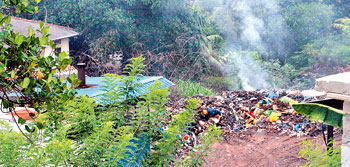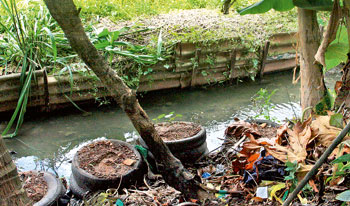| Godigamuwa is a village in Maharagama, close to the National Cancer Institute, and the first thing a visitor notices is a strong chemical odour in the air. A waterway that flows past the houses of Godigamuwa carries waste water and chemical effluents discharged by the cancer hospital. Most of the houses in this highly populated part of Maharagama are permeated by the chemical odour.
Residents say the colour of the waste water changes from red to blue to black, and even discarded syringes, pieces of used gauze, saline tubes and medicine vials are seen floating in the waste water. The discharge ends up in a field where children play and residents grow rice and vegetables. According to residents, the hospital releases waste water into the drains at least three times a day. The odour is especially strong at night, they say.
 |
| As hospital garbage burns, the neighbourhood is polluted with smoke and chemical odours |
 |
| Cancer hospital waste water and other hospital garbage fill drain flowing past homes in Godigamuwa. Photos: J. Weerasekera |
This has been going on for almost 10 years, says Mrs. Amitha Damayanthi, a Godigamuwa resident. Over the years, residents have lodged complaints with the authorities, but no action has been taken.
“The stench is overpowering at times,” Mrs. Damayanthi told the Sunday Times. “This is a big embarrassment for us. When relatives and friends visit, they refuse to have a cup of tea made in our house. My mother died of cancer. My son plays in the field and has black spots on his feet. The doctors say his skin is burnt by chemicals.”
Whenever Mrs. Damayanthi brings up the waste water issue with the authorities, she is asked why she and her family continue to live in the area.
“The families here have been living in the area for more than five decades. Even if we wanted to move, we cannot sell our land and houses. No one wants to buy land here, because of this very problem,” she said.
Rainy days are the worst, says Godigamuwa resident Ramya Perera. “The drain at the top of the road overflows and our houses are flooded by this stinking waste water,” she said. “When the water subsides, the garden is littered with used saline tubes, empty medicine bottles and dirty cotton wads.”
Mrs. Perera suffers from a persistent skin problem, which she attributes to unhealthy living conditions.
Ramani Chandrakumari owns a house near the cancer hospital’s mountainous, sprawling garbage dump. She says the two incinerators on the hospital premises are broken and the hospital’s garbage is burnt outside the hospital, out in the open. “They burn large amounts of plastic materials, and the whole area is filled with smoke.”
Sri Lanka’s premier cancer hospital – established more than 50 years ago, in 1956 – treats up to 1,000 in-house patients at any given time. The hospital does not have an Environmental Protection Licence (EPL). These licences are issued by the Central Environmental Authority (CEA).
“The Environmental Authority is to hold discussions with the Ministry of Health on proper clinical waste management at all hospitals, including the Cancer Hospital,” Central Environmental Authority chairman Charitha Herath told the Sunday Times. “The issue with the Cancer Hospital is an accumulation of cytotoxic waste.”
Cytotoxic waste is a by-product of the cytotoxic therapy and treatment given to cancer patients. Cytotoxic waste includes needles, syringes, and vials. Body fluids from cancer patients, as well as the clothes they wear, also constitute cytotoxic waste.
 |
 |
 |
| Ramya: Living with refuse |
Amitha: Embarrassed |
Amitha’s son: Feet burnt |
According to Dr. Herath, the National Cancer Institute has sought permission to build a concrete pit where the hospital’s clinical waste can be disposed of and sealed off. But a solution for the hospital’s waste water and effluents has not yet come up for discussion.
Waste collected from the Cancer Hospital wards is separated and put in coloured garbage bags. Yellow bags are for clinical waste, blue bags for paper materials, red for plastics, and orange for waste from chemotherapy and other radioactive sources. The Sunday Times learns that all garbage types are dumped in one place, along with organic waste. Every day, the chemotherapy unit generates at least eight bags filled with clinical waste. Disposed of bottles and phials in the orange plastic bags often contain remnants of drugs.
“The Maharagama cancer hospital uses a number of radioactive sources to treat patients,” said Anil Ranjith, head of the Radiation Protection Division of the Atomic Energy Authority (AEA). “Radiation and chemo drugs are used to kill cancer cells. The waste water should be cleaned up before it is released into populated areas.”
Iodine 131 is a radiation-generating medication administered, by injection or orally, to thyroid cancer patients, Mr. Ranjith told the Sunday Times.
“The body release radiation through exhalation and urine, and that’s why thyroid cancer patients should be isolated for at least a week,” Mr. Ranjith said. “Urine from thyroid cancer patients is kept in a delay tank for at least one month, to give time for the radiation effect to wear off. Ideally, the urine should be released into large bodies of water. There should be a proper drainage facility, one that reaches large bodies of water. This would minimise any ill-effects.”
The AEA says the hospital should handle a maximum six thyroid cancer patients a week in order to have better control over urine waste. But this is not feasible, considering the high number of cancer patients that come to the hospital, Mr. Ranjith said.
Soil can absorb radiation, and the tainted soil will inevitably contaminate whatever grows in the soil, Mr. Ranjith added.
Meanwhile, other authorities are blamed for the problem of hospital waste disposal. National Cancer Institute deputy director Dr. Wasantha Dissanayake says the Urban Council was not doing its bit by collecting organic waste. He said the hospital was struggling to deal with the garbage problem.
“In the’90s, the Maharagama Urban Council would collect the hospital’s organic waste, while the clinical waste would be buried in the hospital premises,” Dr. Dissanayake told the Sunday Times. “Over the past 15 years, the hospital has undergone major development. There are more buildings, more patients, and new treatment procedures. The daily volume of clinical waste has also greatly increased.”
Dr. Dissanayake said donors were helping the hospital to build a large concrete bunker for dumping and sealing off hospital waste materials. However, government involvement would be needed to sort out the hospital’s waste water problem, he said.
Skin, respiratory diseases common among families living in vicinity of hospital
Skin disease and respiratory illness are common health problems among families living in the vicinity of the National Cancer Institute, in Maharagama, according to Dr. Nelum Perera, Medical Officer of Health for Maharagama.
“Exposure to chemicals and cytotoxic waste can have long-term effects, and could even lead to cancer,” the doctor said. “No investigations have been conducted into the state of health of residents living close to the hospital, and no studies have been conducted on the effects of hospital chemicals and other effluents on the soil in this area. A cleansing procedure should be followed before the hospital’s waste water is released into open drains.”
Because the Maharagama Urban Council is not collecting the organic waste, the hospital authorities are compelled to dispose of the waste by burning it.
The Maharagama Urban Council chairman Kanthi Kodikara refused to comment on the matter, despite several attempts by the Sunday Times to talk to her about the health situation of residents living in the vicinity of the Maharagama cancer hospital.
US Government will help in removing and disposing of radioactive waste, says Minister
The Sri Lanka Government is to get US Government assistance to remove radioactive waste from hospitals and institutions of scientific research.“At present, the transportation and disposal of radioactive waste from the cancer hospital is not being done according to international safety standards,” the Minister of Power and Energy, Champika Ranawaka, told the Sunday Times. The Minister was referring to the US government’s offer of assistance to Sri Lanka in disposing of radioactive waste.
“The US government will fund and provide technical support in transporting, storing and disposing radioactive materials.”
 |
| Minister Ranawaka: Safety first |
Under its Global Threat Reduction Initiative (GTRI), the US government will undertake to safely dispose of radiation-related materials from the National Cancer Institute in Maharagama, the cancer units in Kandy, Galle, Badulla, Jaffna and Anuradhapura, the Human Tissue Bank, the Atomic Energy Authority, and several private hospitals.
Referring to discussions relating to the introduction of nuclear energy to Sri Lanka, Minister Ranawaka said the authorities were looking at such aspects as non-destructive testing to detect nuclear leakages.
“A centre will be established in Kelaniya for this purpose,” he said. “Also a centre will be established in Biyagama for gamma irradiation [sterilising medical equipment].”
An Atomic Energy Regulatory Council, under the Atomic Energy Authority, will look at nuclear safety, nuclear-related development, medical and research projects, and environmental impact, the Minister said. “The Atomic Energy Regulatory Council Act will be presented to Parliament shortly. It covers laws and safety measures in the handling of radioactive material and other issues relating to nuclear energy. The present law on nuclear energy is the Atomic Energy Act of 1969,” Minister Ranawaka said.
Referring to Sri Lanka’s concerns over South India’s nuclear power generating plants in Kalpakkam and Koodankulam, close to Mannar and the Jaffna peninsula, the Minister said,
“The government is in discussions with the Indian nuclear agencies, and they will come up with a contingency plan. Meanwhile, the Atomic Energy Authority has been advised to get technical support from the International Atomic Energy Agency on safety measures,” Minister Ranawaka said.
Atomic Energy Authority chairman Dr. Ranjith Wijewardene told the Sunday Times that five radiation-detecting systems will be installed along the west coast of Sri Lanka, between Colombo and Jaffna. The detection systems will be installed at Navy bases. The project will be funded by the International Atomic Energy Agency.
The number of scientists working at the Atomic Energy Authority has been increased from 23 to 48, following the nuclear disaster in Fukushima, Japan, and the mushrooming of nuclear power plants in South India.
Two radioactive sources in Kandy that were used for agricultural research but are no longer in use will be sent to India for disposal and transportation. The US Government will cover the transportation and disposal costs.
|







